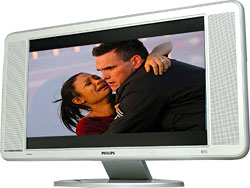|
|
If that's what they're saying now, imagine what they'll say when the World Cup begins in June. With high-definition, crystal clear, pictures, hang-on-the wall plasma and LCD (liquid crystal display) tvs make telly viewing a whole new experience.
Plasma technology was invented in the 1960s and uses fluorescent lights whose main element is a plasma gas, to form an image. But tv companies dismissed the new technology as an alternative to the bulky cathode ray tubes (CRT) which gave the tv its nickname 'the tube' because of the huge investment needed.
It was only in 1999, after Japanese company Matsushita launched a joint venture with plasma inventor Larry Weber, that the plasma display panel got popular. Since then, millions of people worldwide have gone plasma and just as many have the slim tv on their shopping list.
In Nepal the passion for plasma is growing but ownership is still limited to a niche market due to the high prices. Even the most expensive CRT tv is less than Rs 20,000 but the starting price for LCDs and plasmas are in the six figures: rising to Rs 400,000 depending on screen size.
Although distributors aren't selling too many at the moment, they are confident it will not take long before more people opt for the flat, sleek tvs. "The market is still too small for plasma and LCD tvs in Nepal but we are hoping that it will get better in another three years," says LG's SC Saboo.
Prices are expected to drop further in the coming year, after being halved in just a few years. "Barely two years ago, you could buy a car for the price of a plasma tv but now they are quite affordable," says Dinesh Shrestha from Trade Link International, the local distributor of ViewSonic, a US manufacturer.
Not long ago, huge flat projection tvs were being hyped but the technology wave has already swamped that fad and today they are dismissed as just 'boxes'. And with reason: their picture quality pales in comparison to plasma and LCD displays.
To make it easier for you to take the plunge and order your own plasma some companies have arranged financing just like taking a car loan so you can watch the big screen at home while paying for it in monthly instalments.
"Plasma sales are still negligible but we can expect a gradual shift in the near future," says Samsung's Shekhar Golcha. Tube sets still account for 95 percent of tv sales, 80,000-100,000 units every year, half of them in Kathmandu alone. Their prices have been slashed more than 100 percent in less than 10 years. But dealers add that even without large-scale marketing, plasma and LCDs will quickly replace tubes, just as the black and white tv now rests in the technology graveyard.
"The tv market trend has changed so much because there are just too many choices," explains Amrit Kansakar from Sony Television. Even tv distributors have got a break, with the government reducing import taxes from 60 percent six years ago to only 35 percent today, helping sellers to offer tv at prices reasonable enough for most urban families.
"Our role is to introduce new technology, so that buyers have more choices," says Saurav Jyoti of Syakar , which introduced Philips plasma sets here nearly five years ago. Other leading companies include Sony, Samsung, LG and Viewsonic.
"The best thing about electronic technology is that quality improves and the price falls every year and it's the same for televisions," says Tarun Bajracharya From D&D International.
All manufacturers are rushing to cash in on the Football World Cup in Germany in June when they expect a rush from people wishing to upgrade from CRTs to LCDs and even plasma.
The future is laser
 Considering how fast we've moved from semi-flat, to flat, then Plasma and now LCD monitors it is hard to predict what is next. Maybe gigantic 120 inch screens, or how about theatre quality digital projectors?
Considering how fast we've moved from semi-flat, to flat, then Plasma and now LCD monitors it is hard to predict what is next. Maybe gigantic 120 inch screens, or how about theatre quality digital projectors?
"What's next in monitors is left to your imagination," says Saurav Jyoti from Syakar, Nepal's representative for Phillips. What is certain is that the future will be digital and laser tvs. Like inventors say: make it and you'll find the gadget addicts to buy it. This is so true of plasma and LCD sets, which the tv industry was initially sceptical about.
In just a few years, they have revolutionised the industry in the US, Europe and Asia. Even in India, production of tube tv's has stopped as many consumers shell out huge dollars for the latest rage.
It is estimated that plasma and LCD sales will double in the next year, aided by diminishing prices. Asian tv makers have turned their attention to mass marketing LCDs, with Samsung alone predicting sale of 40 million next year, more than double its 18 million units in 2005. Plasma sales this year nearly doubled, to nine million from just five million last year.
But the real future will be digital and laser television, Mitsubishi, which will launch its laser tv in 2008, says that it will have far superior picture quality with bright, deep images thanks to the red, blue and green lasers that will generate images.



